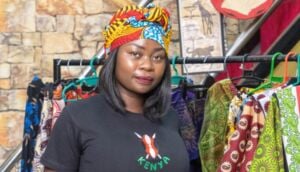In the run-up to the International Day of Persons with Disabilities on December 3rd, David Grayson, who is a member of the Business Fights Poverty Circle of Advisers and the chair of the international, pan-disability charity Leonard Cheshire, argues that businesses and society need a “reset” on disability.
Apparently, the Harvard economist and author Rebecca Henderson was asked at the height of the pandemic restrictions, if we would ever “get back to normal.” She expressed a desire to do things like enjoy a meal in a busy restaurant or hug a friend again, “but otherwise, I hope we never, ever go back” to things like inequalities or unwillingness to decarbonise economies. I imagine that all of us involved with Business Fights Poverty, will have our own lists of “normality,” we too don’t ever want to go back to. High on my list, is the poor treatment and still, sometimes, downright discrimination against disabled people in the workplace.
As the World Health Organisation (WHO) reminds us:
- “Disability is part of being human. Almost everyone will temporarily or permanently experience disability at some point in their life. Over one billion people – about 15% of the global population – live with some form of disability and this number is increasing.”
- Disability results from the interaction between individuals with a health condition such as cerebral palsy, down syndrome and depression as well as personal and environmental factors including negative attitudes, inaccessible transportation and public buildings, and limited social support.
- People with disability experience poorer health outcomes, have less access to education and work opportunities, and are more likely to live in poverty than those without a disability.”[i]
This WHO definition is important because it clarifies that disability isn’t just about having some condition (in my case, limits to my mobility as the result of a childhood bone disease), but also about the barriers: physical, attitudinal etc that society imposes too.
If you take into account a whole host of environmental and other barriers, eighty per cent of persons with disabilities live in developing countries, according to the UN Development Programme.[ii] (WHO) The World Bank estimates that 20 per cent of the world’s poorest people have some kind of disability, and tend to be regarded in their own communities as the most disadvantaged. (World Bank)
An estimated 386 million of the world’s working-age people have some kind of disability, according to the International Labour Organization (ILO). Unemployment among persons with disabilities is as high as 80 per cent in some countries[iii]. In the UK, there is a stubbornly persistent Disability Unemployment Gap of almost thirty percentage points (28.8%) – this is the gap between the percentage of disabled and non-disabled people of working age in work. And remember that most disabilities – around 80% in fact- are not immediately visible [iv].
Some employers assume that persons with disabilities are unable to work (ILO)[v] or it would be too much hassle. A recent report from Leonard Cheshire found that sadly 1:5 UK employers surveyed say they would not employ a disabled person. But looked at another way, that means that 80% of employers would, and given that 10-12% of the workforce of any large organisation in the UK will have a disability and/or long-term health condition, most already do employ a disabled person. We need to make it easier for the 80% to do so – whilst challenging the 20% on why they would want to remain in the bottom 20%! And pointing out that large organisations typically are already employing disabled, even if they don’t realise it – it’s just that employers lack the necessary understanding of the impact of disability on their organisations.
International data in 2020 reveals only 3% of media articles discussing diversity referenced disability. I am getting tired of businesses announcing “major new initiatives on diversity and inclusion” but when you investigate, you find these relate to gender and / or race. Now, don’t get me wrong! There is an urgent need to do far more to improve opportunities in the workplace for women and for people from different ethnic backgrounds; but there is an equal urgency to improve opportunities for disabled people too! After all, with talk of “The Great Resignation” and an intensifying “war for talent,” it just doesn’t make economic sense for businesses to cut themselves off from substantial pools of talent! To do so, is to risk putting themselves at a competitive disadvantage!
Some practical starting points include doing an audit of the workplace and systematically learning from disabled people as colleagues, customers, expert advisors, and fellow citizens. Employers need to begin to ask; What happens when a graduate with a visual impairment tries to apply for a job through our on-line recruitment process? What happens when a colleague with a disability asks for an adjustment so they can be more productive? What happens when a customer with a disability asks for assistance in our stores?
Susan Scott-Parker, a global expert on how organisations can make themselves more attractive to disabled employees and disabled customers, recalls:
“John Varley when Barclays Global CEO launched his ‘Listening Groups’ years ago – inviting anyone in Barclays willing to help them improve their disability performance to join him over coffee so he could listen and learn.. ..He then enabled the business improvements that in turn benefited persons with disabilities as colleagues, potential colleagues and customers.”
Disabled employees’ network can play a key role in enabling this ‘learning directly’ strategy and if the organisation doesn’t yet have such an employee network, perhaps it is time to encourage and support one? There is a wonderful network of disability networks called Purple Space which “is the world’s only networking and professional development hub for disabled employees, network and resource group leaders and allies from all sectors and trades.”[vi] PurpleSpace lead the exciting #PurpleLightUp movement which every December 3, the UN International Day of Persons with Disabilities sees hundreds of organisations celebrating the economic contribution of persons with disabilities, worldwide.
At Leonard Cheshire we have been operating an internship scheme in the UK, placing disabled undergraduates at the end of their degree courses with participating employers. The students get valuable work experience and something extra for their cv, whilst the employers get practical insights into what practical adjustments may help them attract more disabled talent. Our programme is well-regarded but we can still learn from the success of other initiatives like the 10,000 Black Interns programme: https://www.10000blackinterns.com/
Only once an organisation has built up trust internally and externally, is it appropriate to consider asking employees if they consider they have a disability. Many employees are reluctant to “come out” because they fear discrimination or see no upside. Employers will need earned credibility if they are to persuade employees to share this personal information’ This credibility take time – building trust takes time. This means explaining carefully why the information is being requested, how it will be used and demonstrating a genuine commitment to improve opportunities, as a result of having better data.
Organisations like the Business Disability Forum in the UK help to identify and promote good practice amongst employers. And the ILO encourages similar coalitions of employers committed to working together, learning from each other and disseminating good practice, in other countries. The ILO Global Business and Disability Network now has 33 national networks and over 30 international companies such as Accenture, Atos BNP Paribas, Cap Gemini,GSK, IBM, L’Oreal, Salesforce and Standard Chartered Bank. http://www.businessanddisability.org/
I am particularly excited by the announcement in May that the Valuable500 has now recruited 500 companies across the world, who have committed to make disability a boardroom agenda item and to make at least one concrete commitment to action. It is the world’s biggest community for business disability inclusion. The membership includes 36 of the FTSE 100 companies, 46 of the Fortune 500 and 28 of the Nikkei. It includes Apple as the iconic partner of Valuable500 for inclusive design. https://www.thevaluable500.com/
The theme for the 2021 IDPWD is ‘Leadership and participation of persons with disabilities toward an inclusive, accessible and sustainable post-COVID-19 world.”
My hope, therefore, is that by the time we celebrate the International Day of People with disabilities in 2022, the national Corporate Responsibility and Sustainability coalitions such as the national chapters of the UN Global Compact, and the national affiliates of the World Business Council for Sustainable Development will have reached out to the specialist business and disability coalitions and examined concretely how together they can champion better support for disabled people who want to work and could work, to be helped into employment as an integral part of the Just Transition and of fulfilling the Sustainable Development Goals. After all, there are multiple specific references to disabled people across the SDGs – notably
- Goal 4 on inclusive and equitable quality education and promotion of life-long learning opportunities for all focuses on eliminating gender disparities in education and ensuring equal access to all levels of education and vocational training for the vulnerable, including persons with disabilities.
- In Goal 8: to promote sustained, inclusive and sustainable economic growth, full and productive employment and decent work for all, this expressly includes for persons with disabilities, and equal pay for work of equal value.
- Goal 10, which strives to reduce inequality within and among countries by empowering and promoting the social, economic and political inclusion of all, including persons with disabilities.
- Goal 11 on work to make cities and human settlements inclusive, safe and sustainable. This includes expanding public transport, with special attention to the needs of those in vulnerable situations, such as persons with disabilities. In addition, the proposal calls for providing universal access to safe, inclusive and accessible, green and public spaces, particularly for persons with disabilities.
Indeed, it is impossible to deliver the SDGs if persons with disabilities are left behind.
As someone whose professional life is focused on businesses and sustainability, I passionately believe that we must get much better at joining the dots and making the connections across silos of activity. So, specifically in this case, I want to see the sustainability-related business led networks becoming much more proactive in making the links between disability and the achievement of the SDGs.
Actually, now I think more about this: how best to build the effective linkages for this reset, feels like fertile ground for a Business Fights Poverty Challenge!










